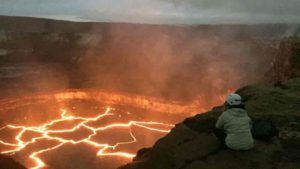
“We’re Barely Listening to the U.S.’s Most Dangerous Volcanoes,” read the headline on a recent story in the New York Times, pointing to the dismal state of volcano monitoring in the Pacific Northwest.
UO earth scientist Leif Karlstrom believes that same headline could also be interpreted literally — he wants to teach others about volcanoes through an ambitious initiative he calls the Volcano Listening Project that seeks to express and understand volcanic data through sound.
As Karlstrom explains, the human brain has evolved to react to and interpret a world full of sounds. This is a practical survival skill when faced with the sound of a falling tree or an approaching city bus, and sound through music can be a compelling window into human emotion.
“Most people regularly listen to music, but rarely do we think of sound as a means of interpreting scientific data,” Karlstrom said. “My goal is to bring volcanoes — safely! — into public spaces, exploring complex scientific data in surprising and hopefully interesting ways.”
The project is part of Karlstrom’s Career Award from the National Science Foundation, which he received in spring 2019 and includes a five-year plan to further develop his Volcanic Listening Project to generate sounds from data recorded at erupting volcanoes. He will use this so-called “sonified” data to inform scientific interpretations, as well as to make and perform music.
A professor in the Department of Earth Sciences, Karlstrom characterizes his research as “fluid and solid mechanics applied to volcanoes and glaciers.” When a volcano erupts, Karlstrom says, scientists record ever-increasing amounts of information, which can include photographic or video imagery, gas emissions, deformation of the ground, subsurface earthquakes and chemical compositions of erupted lavas.
Karlstrom and his collaborators have developed computer programs that translate these volcanic data into sound, at which point Karlstrom puts on his music hat to examine the results. As a lifelong musician, he earned a degree in violin performance from the UO and has been playing professionally for nearly 20 years.
After earning his doctorate in earth and planetary science at the University of California, Berkeley, he helped start a number of groups in the San Francisco Bay Area. These include the band Front Country in 2012, now a full-time group based out of Nashville that tours internationally, and the duo Small Town Therapy.
For Karlstrom, combining scientific research with music doesn’t often happen, but with this new project he has found a pairing that he says makes sense.
“Sound provides emotional experiences as well as an intuitive way to grapple with the scientific goals of understanding patterns and peering through noisy data,” Karlstrom said, adding that he hopes to use these contrasting, biologically hardwired relationships to teach people about volcano science.
“Millions of people are affected by volcanoes and the hazards associated with them,” Karlstrom said. “We are exploring new ways to engage with awe-inspiring parts of the natural word, which operate on scales that are well outside the normal human experience. ”
Karlstrom will continue to build out his Volcano Listening Project to include learning materials for those interested in data sonification and visualization. He will also promote musical composition and performance based on volcanic data.
The first iteration of the Volcano Listening Project features a collaboration between Portland-based visual artist Zack Marlow-McCarthy and Karlstrom’s group Small Town Therapy. It includes the track “Hotel Kilauea” from their 2019 record. A merging of art and science, the track is a blend of acoustic instruments mixed with computer-generated sounds from data collected at Kilauea volcano in Hawaii between the years 2000-10.
‘Hotel Kilauea’ is UO earth scientist Leif Karlstrom’s multimedia work, which depicts 10 years of data collected at Hawaii’s Kilauea volcano, compressed into a little more than three minutes. Raw data associated with ground deformation and gas emissions are ‘sonified,’ then used as the basis for musical improvisation.
Computer sounds were used as the basis for free improvisation of the data by Karlstrom and three other musicians who formed an ensemble of two violins, guitar and upright bass. The performance follows in the footsteps of free jazz exemplified by artists like John Zorn or Ornette Coleman, known for their ability to stretch the conventional use of tempo, rhythm, and harmony and perform in a completely improvised manner.
“The challenge (of free improvisation) is, can you make art if there are no rules?” Karlstrom said. “Can you make it up on the spot? Is it still musical or is it just noise?”
The video released along with Hotel Kilauea is based both on the data and on musical performance. It animates the transformation of a volcano over time with an abstract touch, much as the music provides an abstract interpretation of the raw volcanic data. A detailed listener’s guide for the track is available on the project website.
Karlstrom is working on installations of the Volcano Listening Project that will debut nationally over the coming years, starting with the Centennial Theater at the American Geophysical Union Fall Meeting in San Francisco in December.
He also hopes that others will latch on to volcano music, which he views as a steppingstone for creating new ways to engage the public around science.
“Science is a creative enterprise, just like music,” Karlstrom said. “I am hoping that the Volcanic Listening Project can help generate new knowledge about volcanoes as well as compelling new art.”
Note: The above post is reprinted from materials provided by University of Oregon.









